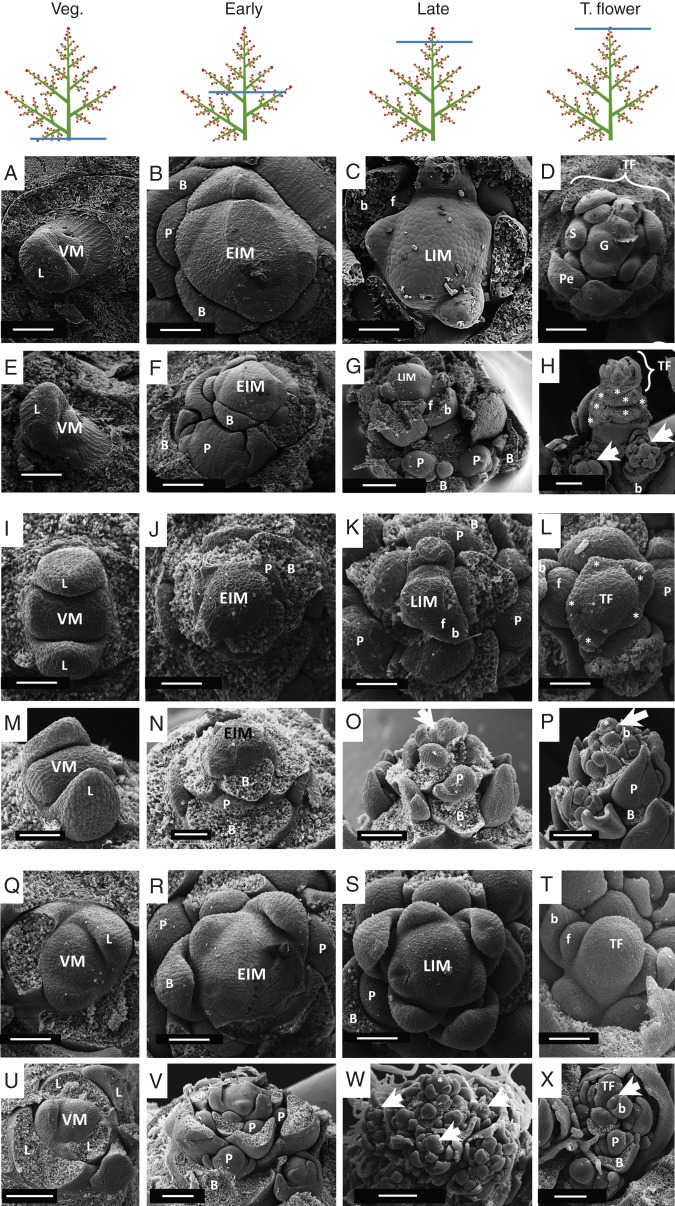Fig. 4.
SEM images depicting the ontogeny of panicles. Images are organized in columns according to the ontogenetic state: first column, vegetative meristems (VM); second column, early inflorescence meristems (EIM) forming lateral partial inflorescences (P); third column, more advanced developing inflorescences topped by their late meristems (LIM) that produce lateral flowers (f); fourth column, formation of the terminal flower (TF). (A–H) Nandina domestica: (A–D) top views, (E–H) side views of apical meristems; (A, E) vegetative meristem (VM) producing a large leaf primordium (L); (B, F) early inflorescence meristem (EIM) originating few lateral partial inflorescence primordia (P) subtended by bracts (B); (C, G) late inflorescence meristem (LIM) with distal flower primordia (f), proximal partial inflorescence primordia (P) and their respective subtending bracts (labelled B and b) – note that the LIM is smaller than the EIM in (B) and (F); (D, H) young terminal flower (TF) that has developed from the late inflorescence meristem. Stamen (S), petal (Pe) and gynoecium (G) primordia are visible as some lateral young flowers (arrowheads). Asterisks indicate scars of sepals of the TF. (I–P) Phlox drummondii: (I, M) vegetative meristem (VM) with opposite leaf primordia (L) in decussate phyllotaxis; (J, N) EIM showing transition to spiral phyllotaxis, lateral partial inflorescence primordia (P) and subtending bracts (B); (K, O) LIM showing incipient bract (b) and flower primordium (f), partial inflorescence primordia (P) and their respective subtending bracts (B) – note that the LIM in (K) is smaller than the EIM in (J); (L) developing terminal flower (TF) at the top of the main axis with young calyx (asterisk), lateral flower (f), partial inflorescence (P) and their respective subtending bract (b and B) primordia; (P) same sample as in (L) with partial inflorescences at the base (P), developing lateral flower primordium near the top (arrowhead) and a young terminal flower (asterisk). (Q–X) Macleaya odorata: (Q, U) Vegetative meristem (VM) showing large leaf primordia (L); (R, V) early inflorescence meristem (EIM) showing lateral partial inflorescence primordia (P) and their subtending bracts (B); (S, W) late inflorescence meristem (LIM) – note that the late inflorescence meristem is smaller than the early inflorescence meristem (EIM) in (R); (T) young terminal flower (TF) terminating the axis – note its developmental advance in comparison with the lateral flower primordia (f); (X) partial inflorescence showing the terminal flower (TF) at the top of the axis, lateral flower primordia (arrowhead) subtended by bracts (b) near the TF and partial inflorescence primordia (P) subtended by bract (B) near the base. Abbreviations: VM, vegetative meristem; EIM, early inflorescence meristem; LIM, late inflorescence meristem; P, partial inflorescence; B, subtending bract of a partial inflorescence; b, flower subtending bract; S, stamen primordium; Pe, petal; G, gynoecium. Other abbreviations as in Fig. 2. Scale bars: (A–E, I–N, Q–T) = 100 µm; (F, G, O, U, V, X) = 200 µm; (H, P, W) = 400 µm.

